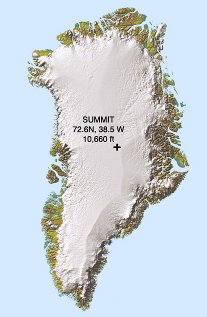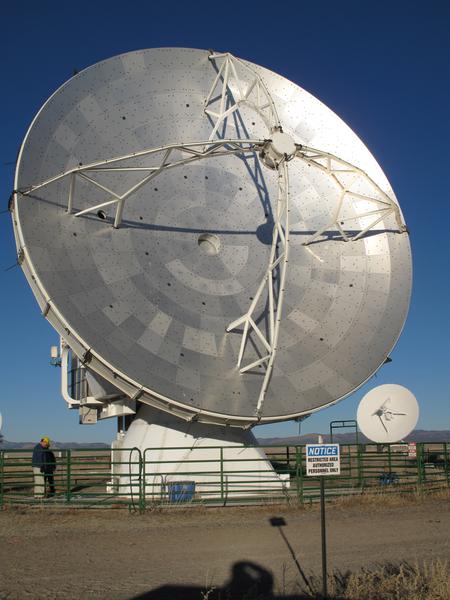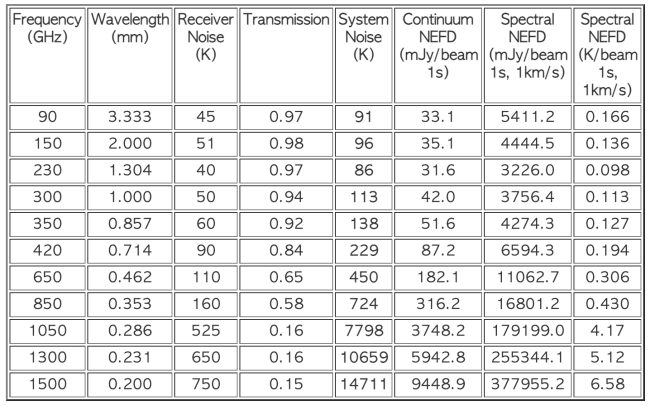The 12M Telescope
Thule Air Base
The Greenland Telescope is currently installed and operating on the Thule Air Base in Greenland. This sea level site, located 750 miles inside the Arctic Circle, has provided a unique opportunity to build and test under arctic conditions while providing crucial access to logistics and support. Water vapor above the site is continuously monitored and, as expected, impacts our ability to use the higher resolution 345 GHz receiver currently installed. We are having great success with the 86 GHz and 230 GHz receivers.
Summit Station
In order to fully utilize higher resolution 345 GHz receivers, the telescope needs to operate in a drier environment. Few sites in the world offer the type of environment necessary; the summit of the Greenland ice sheet is one of them. This location will also provide a northern most leg of VLBI networks necessary to truly achieve resolutions required to image black holes.
Funding dependent, the Greenland Telescope will be deployed at Summit Station, Greenland. This Arctic research station is funded by the U.S. National Science Foundation (NSF) Office of Polar Programs. It is anticipated that the Greenland Telescope would be constructed 5 miles north of the existing Summit Station Camp at 72°35'N 38°25'W and 3,210 m (10,530 ft) above mean sea level. The site is near the peak of the Greenland ice sheet, near the center of Greenland.

The NSF has operated the Summit Station since 1989 and weather data exist for almost all of this period. From 2010, twice daily radiosonde observations have been carried out alongside radiometer observations at 22, 60, 90 and 150 GHz as part of the ICECAPS program, while ASIAA has operated a 225 GHz radiometer from August 2011 through 2015. The site is extremely dry during the Oct-May observing season, with a median PWV column of 0.75 mm and PWV below 0.25mm for approximately 10% of this time. Calculated atmospheric transmission is shown in Figure 02. The site is extremely flat and wind speeds are generally low. Winter temperatures reach -65C during the coldest and clearest conditions.
The site has been manned all year round typically with 5 winter-over staff at Summit, working 10 week shifts, with 1 week overlap at each end. With the deployment of the Greenland Telescope this will need to increase to 12 winter over staff, including 5 dedicated to the Greenland Telescope. Summer staffing levels are significantly higher with maintenance and traverse crew, and summer campaign science operations. Access to the site is via ski equipped Air National Guard C130-LC and charter Twin Otter aircraft from Kangerlussuaq and Thule, and by an annual overland sled traverse from Thule. Twin Otter aircraft can reach site year round, but avoid the 2 month period of total darkness in Dec/Jan.

The Telescope
The Greenland Telescope is based on the ALMA North America prototype antenna built by Vertex AG. The antenna was completely refurbished and rebuilt for operation in the colder and somewhat lower altitude conditions found at Summit Station, Greenland. It is a 12m diameter Cassegrain system with a primary F/d ratio of 0.4 and maximum field of view of approximately 15 arcmin. A nutator will be used to chop the secondary mirror for single dish observations.
The telescope is installed and operating at the Thule Air Base as of January, 2018. Initial installation and alignment of the panels achieved 50µm RMS surface error as measured by a laser tracking system. The surface of the antenna will be set using near-field holography later in 2018. Noting that, a 16µm RMS surface error has already been achieved on this antenna during the ALMA prototype testing. With the additional upcoming holography runs we believe that this antenna should yield reach the 12µm RMS surface currently being achieved on ALMA production antennas. Blind pointing accuracy of 2" will be achieved across the whole sky, with an offset pointing accuracy of 1" .
Philippe Raffin, ASIAA Radio Antenna Engineer, authored an excellent SPIE paper in 2016 summarizing the retrofit status: Raffin, P., et al. The Greenland Telescope: Antenna Status and Future Plan, Proc. SPIE Edinburgh, Vol. 9906-29 (2016)
Instrumentation
The Greenland Telescope Project aims to deploy a suite of state-of-the-art instruments on the telescope. At first light, single pixel, dual polarization sideband separating heterodyne receivers based on ALMA Band 6 and 7 receivers will be available, along with a room temperature W band receiver for holography and pointing tests on continuum and SiO maser sources, with 350 GHz multibeam and sub-mm and THz heterodyne receivers (including small arrays) planned for deployment in subsequent years. The Project is also seeking partners to develop short and long wavelength bolometer cameras for the 450µm-200µm and 1.3mm-850µm windows, and bolometric spectrometer arrays. The GLT will be able to act as a test bed for novel instruments, including those intended for CCAT.
Estimates of sensitivity for heterodyne observations using state-of-the-art single pixel receivers are given in the table below. Backend spectrometer systems for heterodyne receivers are currently being investigated, but we expect to provide both an ultra-wideband system for single-pixel observations and a narrower bandwidth multi-input system for use with multi-pixel receivers. We expect to operate instruments on a campaign basis, with major instrument reconfigurations taking place during the summer months, when access to the site is easier.

TABLE: Estimated heterodyne single-pixel sensitivities for proposed bands on the GLT, assuming tenth percentile weather at the highest frequency bands, and a 12µm RMS surface. SIS receivers are assumed for bands below 1 THz and HEB receivers for bands above 1 THz.